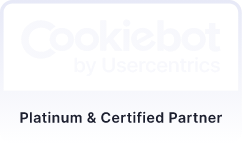Summary
In this article, we’ll outline the end-to-end steps of what takes place in a thorough user experience (UX) and user interface (UI) web design process and discuss what modern web design requires to be successful.
—
You may have read our in-depth guide to creating a brief for a web design and development project. A brief can be used to capture all your ideas and requirements before discussing your project with any web design and development agencies.
Once you’ve completed your brief, and evaluated your options for agency partners, you’ll be ready to launch into your website project.
An end-to-end website project is typically organised into phases, which will usually be structured as follows:
- Design
- Development
- Quality Assurance Testing
- Migration and Launch.
We’ve provided a detailed breakdown of these phases in a recent series of articles. This series is intended to give you a clear understanding of the full end-to-end process involved when working with an agency to design and develop a website. This will help you remove any apprehension heading into this kind of project and set you up for success.
The Current State of Web Design
“Design is not just what it looks like and feels like. Design is how it works.”
Steve Jobs, Co-Founder and former CEO of Apple.
While web design does focus on the visual aspects of the site, there’s a lot more to it than just the aesthetic elements like colour schemes and typography.
Web design is a complex blend of branding, user experience (UX) design, user interface (UI) design, graphic design, content creation, layout and structure, accessibility, and much more.
The design of your website needs to be visually attractive but, more importantly, it also needs to be simple and easy-to-use. Your website needs to find the perfect balance between supporting your strategic objectives and serving your clients with a seamless experience. Of course, that’s much easier said than done, which is why it’s so important to find an experienced partner you can trust to guide you through the process.
Outlining the Web Design Process
Phase 1 – Research and Planning
The phase that underpins EVERYTHING!
A good agency will have absorbed everything in your project brief. They should also have worked hard to understand your perspective and your requirements from your website, before you’ve even agreed to work together.
Once you’re preparing to launch the project, the research and planning phase will then go beyond that initial information gathering exercise.
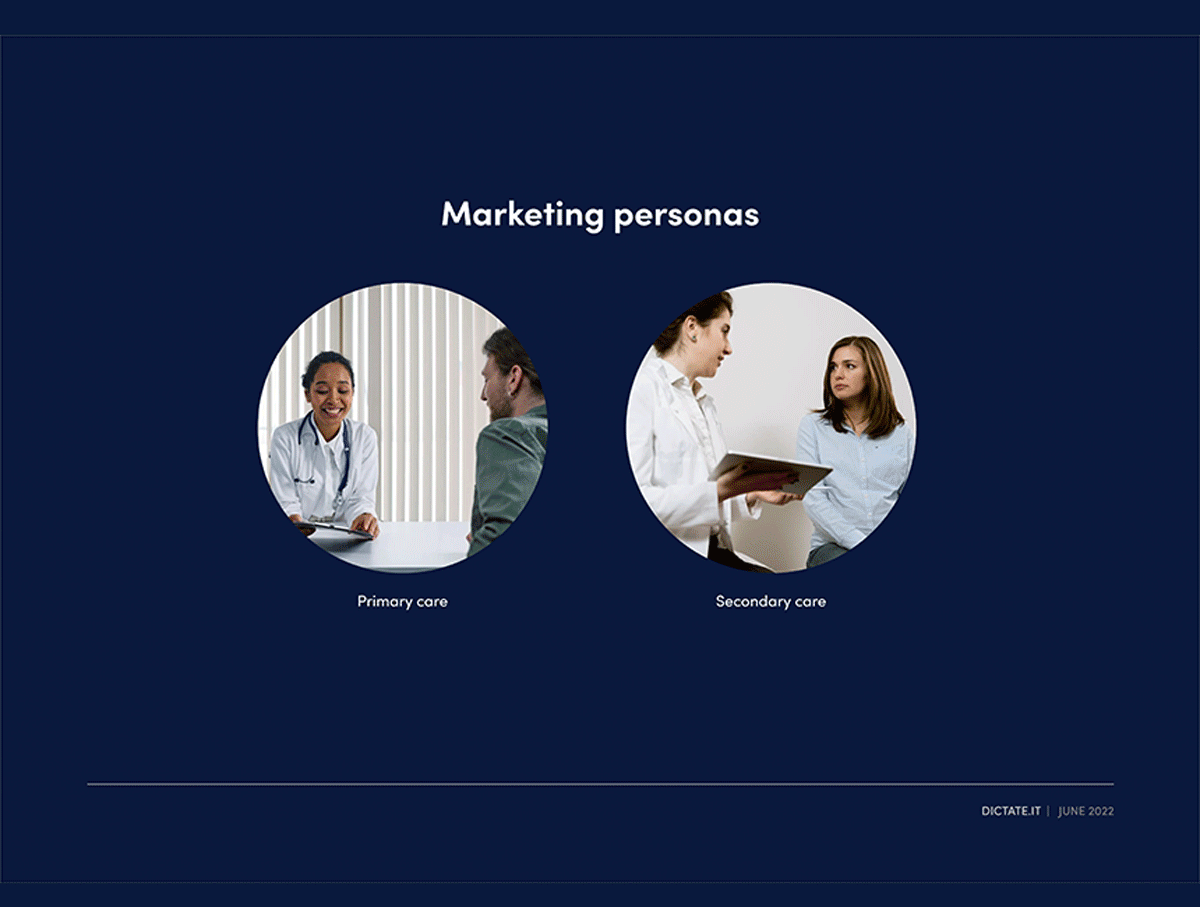
The objective of this phase is to define the full scope of the website, including its design, its features and functionality, its content, and everything else involved.
Your site will be discussed in extensive detail, and then research will be conducted into some key areas that will inform your design and development, such as:
- Strategy
- Website Data
- Target Audience
- Industry Landscape
- Competitors.
Whether you’re making small updates to an existing design or completely rebranding your business, it’s equally important to use this research to inform every decision you make. That’s because every element of your site’s design must be made to support your business goals and serve your target audience with a great user experience (UX).
This research and planning phase is essential in enabling you and your agency partner to do that.
Phase 2 – Visual Exploration
This exploratory phase involves defining the most appropriate and effective visual direction to take with your site.
The main tool used to help determine the right visual identity for your website is a set of mood boards. These are a visual compilation of different options for colour, typography, structure, images, and other visual components that are used to tell your brand’s story through your website’s design.
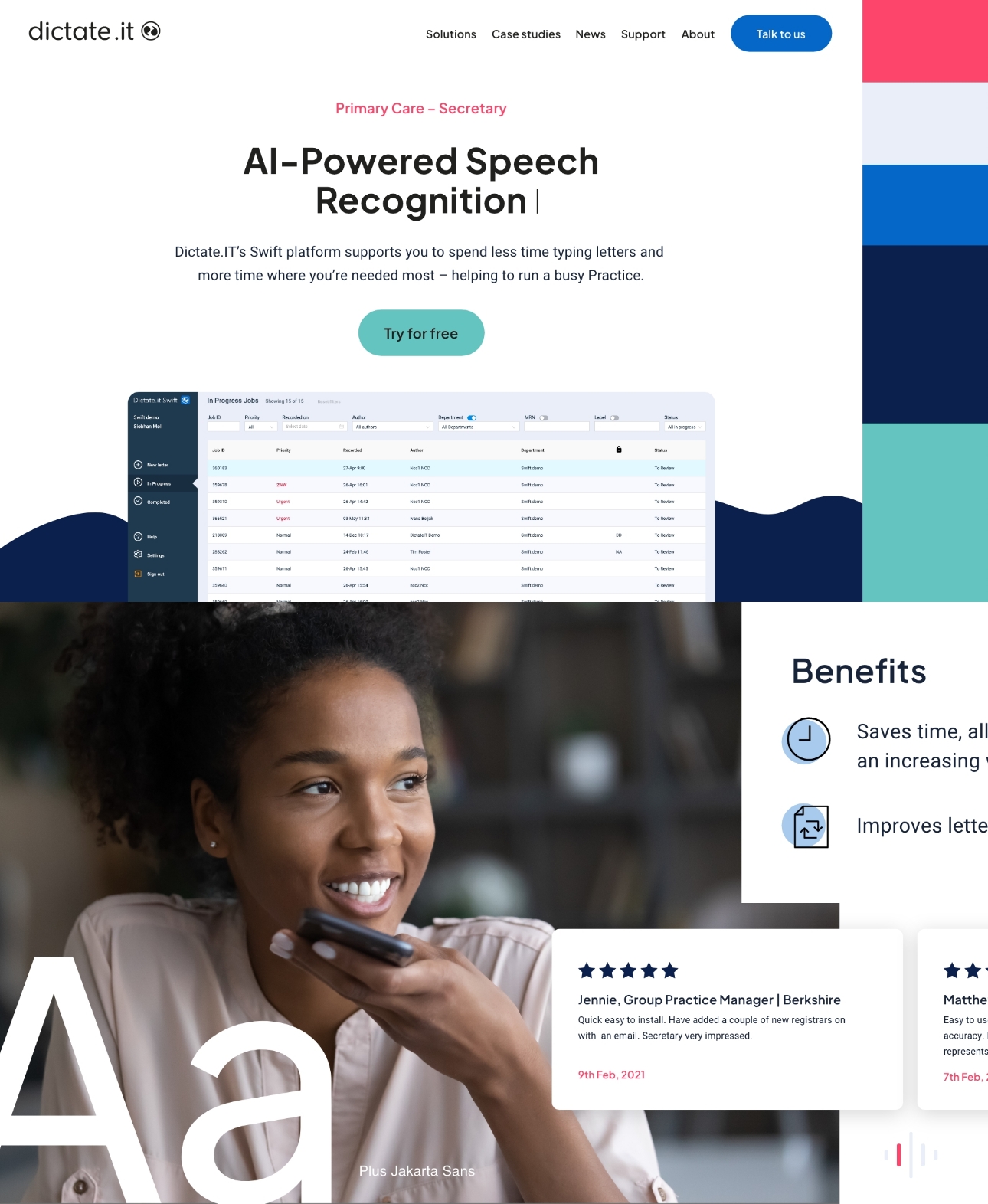
A good agency partner will usually present around three mood boards to help shape the direction, then collaborate with you to narrow it down to one final version.
Visual exploration, like most processes within web design and development, will be collaborative and iterative. You’ll be presented with ideas by your agency partner, then given the chance to provide feedback across several rounds of revisions.
Phase 3 – User Experience (UX) Design
The UX design process is the phase in which you work with your agency’s UX specialist to create a blueprint of the website functionality.
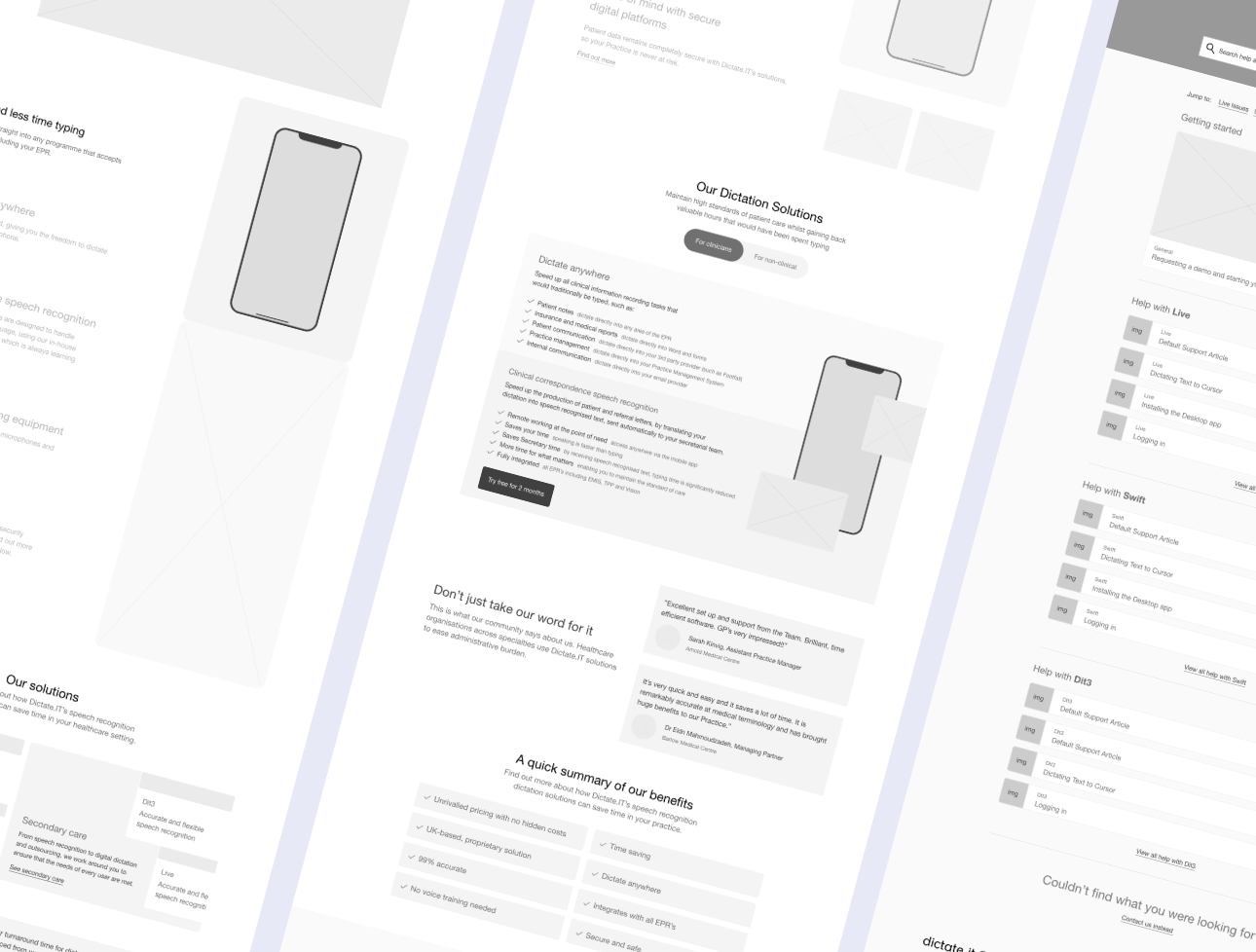
This involves creating wireframes (either low-fidelity or high fidelity) that help you visualise the design and outline your website visitors’ flow through the pages into your main calls-to-action. This is the way the website’s design works strategically to drive outcomes that align with your business goals.
This phase takes place before working on the site’s visual design to ensure the two separate aspects complement each other.
Phase 4 – User Interface (UI) Design
From there, your user interface (UI) will be designed. The styles, fonts, and look and feel of the site from the mood boards will be applied to the wireframes.

Your agency will likely present you with a design for your homepage before moving on to the rest of the site. This will typically be done on a desktop screen size, but it can be done on mobile if you want to take a mobile-first approach. Once this is complete, it will then be designed across the relevant breakpoints.
After completing this process, your agency partner will be ready to enter into developing your website.
Making Complex Processes Simple
As technology continues to become more advanced, more and more of our daily lives now take place in a digital-first context. This means:
- Your target audience now has a shorter attention span, and less patience when browsing websites and services online
- Your target audience also has more choice of options than ever before when choosing who to buy from.
In order to succeed, your website’s design requires careful planning, research, and a strategic approach if it hopes to meet the demands of the modern client.
Working with a specialist design and development agency is a proven approach to ensuring you gain a website that meets your requirements and delivers on the expectations of your target audience.
Completing a process like the one outlined in this article will enable you to design a website that can become your clients’ go-to online source when they have a need.
As mentioned earlier, we’ve provided a step-by-step guide to each of these phases to make the process even easier for you.
Would you like these insights straight to your mailbox?
- Your brand
- Your company values
- Your colour scheme
- Your typography
- Imagery and other visual content
- Structuring of pages
- And other visual components that are used to tell your brand’s story across your website’s design.
- A bespoke website that differentiates you from your competitors
- An online portal, either for training internal users or providing a more engaging experience for your clients
- A new platform that can better integrate with your legacy systems
- A new content management system (CMS) that can provide greater flexibility and scalability
- A way to transform time-consuming, inefficient manual processes into a unique, easy-to-use digital tool.
- Proven financial services sector experience and success
- A strong track record with complex bespoke development projects
- A long-term partner who can advise and guide you to make the correct decisions
- Certifications and accreditations
- Compliance with financial services industry regulations
- Secure hosting, with back-up, disaster recovery, and risk mitigation plans
- Security built into the core of every project
- Automated monitoring, maintenance, and support services
- Ongoing updates and optimisation for your platform
- Training and learning to help you gain maximum value from your investment.
- Improving your internal UX, creating greater operational efficiency
- Improving your external UX, providing more convenient, intuitive services to customers
- Streamlining mission-critical processes to reduce costs
- Building enterprise-grade security into the core of your systems
- Enabling real-time interactions with data
- Increasing customer retention and loyalty
- Achieving competitive differentiation
- Accelerating business growth.
UI Design
18 April, 2023
What is Visual Exploration in the Process of Web Design?
When a visitor lands on your website, the visual design is likely to be the first thing they’ll notice. It’s also usually the thing they’ll remember most.
75% of consumers reportedly judge a business’s credibility based on its website design. This first impression can make or break a prospective client’s interest in working with you.
The ultimate goal of your website is to attract and retain as many prospects as possible, and then convert them into clients. But most websites are designed in a way that leaves those goals unfulfilled, failing to reach their full potential.
With that in mind, your visual identity should be treated as a top priority within the overall design of your website. Believe it or not, this can have a significant influence on the growth and success of your business.
When working on a web design project, you should always go through a careful visual exploration phase to find the right visual identity for your website.
Whether you’re going through a full company rebrand or just refreshing the style of your website, it’s important to ensure your design is tailored to your specific target audience. This is how you begin to drive business growth through your website.
Without a visual exploration process, your website may not convey your company’s brand identity and values as clearly as you’d like it to.
In this article, we’ll outline the steps taken so you’ll know what to expect when working on a website design project.
What Does the Process Involve?
The purpose of this process is to define the best visual direction to take with your site.
This is a crucial aspect of your overall design, with aesthetic elements being brought together to create a look and feel that engages your site’s visitors and retains their attention. To achieve that, your visual design needs to establish a connection between your audience and your brand immediately. It should also demonstrate why your visitors should work with you.
Exploring your visual identity will cover a wide range of elements, including:
What are Mood Boards and How Can You Use them?
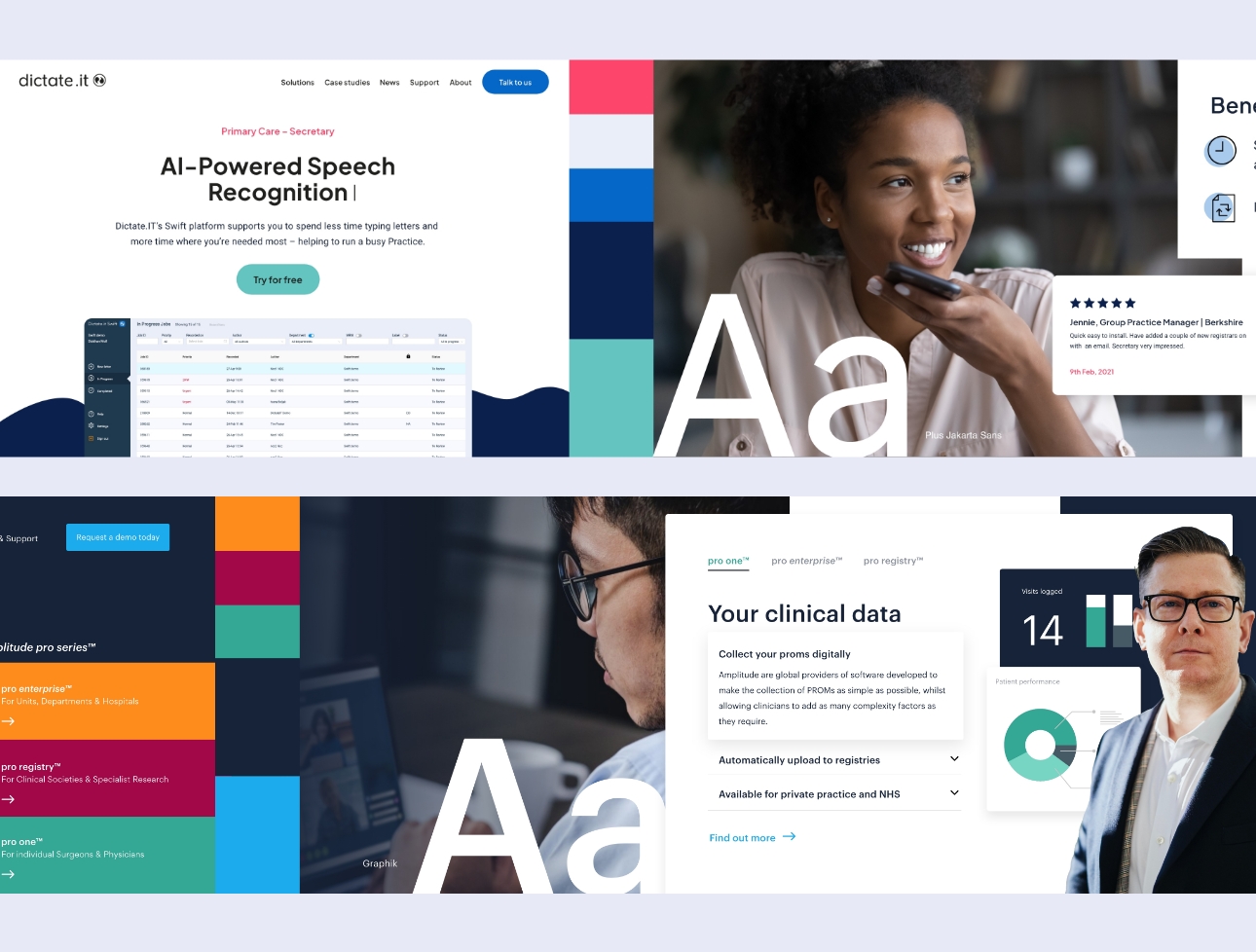
The main tool used to help determine the right visual identity is a set of mood boards.
These are a visual compilation of all the various elements that make up your website’s visual design. Each mood board is essentially just a single-page collage of design styles based on previous discussions and the findings from the research and planning phase of the process.
The aim of these is to capture your brand’s visual style and tone. This will give the stakeholders, and your designers, a shared understanding of the design you’re working towards.
Mood-boarding helps you visualise the work on your website’s design before it begins and agree on a design aesthetic that accurately reflects your brand identity and values.
Think of this like a problem-solving exercise. Your design agency will take a research and data-driven approach to conveying your brand identity, while also catering to your target audience and accommodating the latest industry trends.
Collaboration and Iteration
Like most processes within web design and development, this visual exploration process should be collaborative and iterative.
You’ll typically be presented with a mood board and a set of ideas by your agency partner, then given the chance to provide feedback across several rounds of revisions.
Rounds and revisions are always important in any creative process. It’s usually necessary for your agency to develop and present a minimum of three mood boards before the optimum aesthetic is agreed upon. This is a crucial step towards the ultimate goal of creating a new website that accurately reflects your brand and has a positive impact on your target audience.
Connecting with Your Clients Through Design
Your website’s visual identity is what makes your brand resonate with your target audience. Your design needs to clearly convey the values of your business, the quality of your products and services, and the reason why your visitors would benefit from working with you.
Working through this visual exploration phase is an important step towards designing a website that will attract more visitors and increase your conversions.
Once this visual exploration is complete, the next phase of your web design process will be to craft your website’s user experience (UX).
Would you like these insights straight to your mailbox?
Development
9 November, 2023
Regulation of digital markets: Comparing UK and EU approaches
Digital markets have experienced significant growth and dominance by a few companies and their platforms, raising concerns about competition, consumer choice, and data access. To address these issues, both the European Union (EU) and the United Kingdom (UK) have introduced regulatory reforms.
The EU has implemented the Digital Markets Act (DMA) and the Digital Services Act (DSA), while the UK has proposed the Digital Markets, Competition, and Consumer Bill (DMCCB) and the Online Safety Bill.
We’ll look at the regulatory approaches taken by the EU and UK, highlighting similarities and differences in scope, applicability, the importance of consent and how to get started with compliance.
Data privacy regulations in the European Union
The Digital Markets Act applies to companies designated as “gatekeepers” by the European Commission. Gatekeepers are the owners and providers of what the Commission identified as core platform services (CPS), such as search engines, social networking services, video-sharing platforms, and cloud computing services.
Companies designated as gatekeepers must carry out self-assessments to determine that they have met and continue to meet both quantitative and qualitative criteria. The list of gatekeepers may grow or change over time based on these criteria.
The quantitative criteria include a minimum annual turnover of €7.5 billion in the EU and at least 45 million active monthly users on the relevant platform or service in the last three financial years. Qualitative criteria consider the impact, importance, and market position of the CPS provider.
The DMA’s requirements are similar in many respects to those of the EU’s General Data Protection Regulation (GDPR), but are broader in some ways, addressing additional access to and uses of end users’ personal data.
Data privacy regulations in the United Kingdom
The Data Protection Act 2018 (“DPA”) covers the general processing of personal data in the UK and came into force on 25 May 2018, just before the EU GDPR took effect.
Following the end of the Brexit Transition Period, the EU GDPR became part of UK law through the European Union Withdrawal Agreement, and the Data Protection, Privacy and Electronic Communications Regulations 2019 (Exit Regulations).
The EU GDPR gave rise to the UK GDPR, which came into force on January 1, 2021, as the EU GDPR no longer protected UK citizens’ data. It includes the provisions of the EU GDPR with only minimal changes to the core principles, rights and obligations for data protection.
The UK GDPR and the DPA 2018 (amended version) are now the principal data protection regulations in the UK. They require businesses to protect individuals’ data, obtain consent to collect and use it, and protect data subjects’ rights.
The Privacy and Electronic Communications Regulations (PECR) implemented the EU’s ePrivacy Directive (Directive 2002/58/EC) and sets out privacy rights relating to electronic communications. The PECR came into force in 2003 and .
The “British DMA”: Enter the Digital Markets, Competition, and Consumer Bill (DMCCB)
In the U.K., Parliament has yet to pass the British equivalent of the DMA, the Digital Markets, Competition, and Consumer Bill, or the DSA equivalent, the Online Safety Bill.
The DMCCB applies to digital commercial operations in the UK or affecting the UK market, which are deemed to have Strategic Market Status (SMS). The definition of a digital activity is broad and includes any service provided via the internet.
To qualify as an SMS, a firm must meet criteria such as conducting a digital activity linked to the UK, having substantial market power, and holding a position of strategic significance. Turnover thresholds of £25 billion global turnover and/or £1 billion UK turnover are also considered.
Obligations and requirements
European Union: Digital Markets Act
The DMA imposes various behavioral obligations on gatekeepers. These include allowing third-party interoperability, granting access to user-generated data, promoting fair competition, and prohibiting preferential treatment of the gatekeeper’s services.
Gatekeepers must appoint compliance officers and submit annual compliance reports to the Commission.
Additionally, gatekeepers are required to inform the Commission about mergers (any “intended concentration” irrespective of whether they’re notifiable under the EU Merger Regulation or national merger rules. (DMA Art. 14.).
United Kingdom: Digital Markets, Competition and Consumer Bill
Strategic Market Status (SMS) firms in the UK will be subject to strict behavioral obligations under the DMCCB. These obligations revolve around fair trading, open choices, trust, and transparency.
The specific requirements will be tailored by the Digital Markets Unit (DMU) and the Office of Communications (Ofcom), the regulatory bodies overseeing the DMCCB and the Online Safety Bill, respectively.
SMS firms must also report proposed acquisitions meeting certain thresholds to the DMU.
EU vs. UK processes
European Union: (Digital Markets Act)
The EU’s legislative-driven model designates gatekeepers based on size and imposes behavioral expectations through regulation. The European Commission develops and enforces these requirements for compliance from gatekeepers.
United Kingdom: Digital Markets, Competition and Consumer Bill (DMCCB)
The UK’s approach involves more regulatory discretion. The DMU and Ofcom determine if a company has Strategic Market Status and tailor specific remedies accordingly. This approach allows for a more flexible and tailored oversight of digital platforms.
Participatory regulation
In the UK, both the DMU and Ofcom adopt a participatory regulation approach. This means regulators work closely with target companies to develop behavioral expectations and codes that can be enforced. The companies conduct their own Duty of Care analysis, which is reviewed by regulators that provide guidance and work collaboratively to define behavioral codes.
This means that beyond what’s defined by the two regulations, gatekeepers and SMS are required to determine their own privacy requirements to apply to third-party businesses using their services.
The importance of consent management for EU, EEA and UK companies
While both the European Union’s Digital Markets Act (DMA) and the United Kingdom’s Digital Markets, Competition and Consumers Bill (DMCCB) emphasize the significance of obtaining user consent for data processing activities, there may be variations in specific requirements and implementation.
To address these differences and get ready for data privacy compliance, follow these steps:
1. Understand the regulations
Familiarize yourself with the specific consent requirements outlined in both the DMA and DMCCB. Identify any variations in terms of lawful bases for processing, explicit consent, and additional obligations.
2. Assess your website or online platform’s data processing
Assess your organization’s data processing practices and identify any areas of noncompliance. Scan your website and check its degree of GDPR compliance.
3. Implement a leading European consent solution
Choose a consent management platform that enables GDPR and ePrivacy-compliant user consent collection and signaling for DMA compliance. Ensure that the CMP provides features such as granular consent options, secure recordkeeping, and user-friendly interfaces.
The specifics of CMP implementation do depend on what platforms you’re using, like your CMS, as well as other tools, including Google Tag Manager and other services. Cookiebot CMP is flexible, has direct integrations with leading website platforms, and can be installed with just a few lines of JavaScript. There’s also a cookie WordPress plugin.
4. Customize consent banners
Tailor the consent banners displayed on your website or online platform to meet the specific requirements of each regulation. Provide clear information about data processing activities, purpose specification, and the ability to manage preferences.
5. Update your privacy policy
Review and update your privacy policy to align with the requirements of the DMA and/or DMCCB. Include details about the types of data collected, the purposes of processing, parties with access to the data, and how user consent is obtained and managed.
6. Train your team
Educate your staff about the nuances of both regulations and the proper implementation of consent management. Ensure they understand their roles and responsibilities in obtaining and managing user consent.
Final thoughts
The UK and EU regulatory initiatives are creating de facto global digital risk management standards, by taking significant steps to regulate digital markets and addressing concerns related to market dominance, competition, consumer choice, and data access.
While the EU has implemented the DMA and DSA, the UK is in the process of enacting the DMCCB and the Online Safety Bill. The approaches differ in some aspects, but there’s a shared goal of promoting fair competition and protecting consumer interests.
Would you like these insights straight to your mailbox?
Latest from agency
3 February, 2023
What a Successful Bespoke Development Project Should Look Like for Financial Services Businesses
As a business in the financial services industry, you have to navigate a range of sector-specific challenges that make it difficult to meet current user expectations with technology. This article will explain why a bespoke development project is often the most effective way to solve those challenges, and provide guidance on how to approach such a project.
For a long time, apprehension towards cyber security and data protection, alongside challenges with decades-old legacy systems, meant that many businesses in the financial services sector were a bit behind the technology curve. Banks and other financial services companies weren’t typically known for their impressive websites or sleek digital processes, at least not until fairly recently. Those days are long gone now, though, as digital transformation and technology-driven innovation have changed the financial services industry forever.
Today, both your clients and employees alike expect a seamless digital experience when interacting with your services and processes. And meeting these expectations has become increasingly important over the past 10 years or so, as the more traditional finance businesses have faced disruption from trends like FinTech and digital banking.
But whether you’re a long-standing financial institution, or an early-stage FinTech start-up, there’s a common priority among businesses in this industry – you simply must keep up with the pace of technology in order to stay relevant with your customers and maintain your competitive edge.
Changing Demands from Your Audience of End-Users
The technology trends we’ve highlighted there will have caused you to shift large parts of your business model online over the past few years. Consequently, that will have created a range of new challenges for you.
Self-Service
Whatever services or products you provide, your clients now expect the same convenient, effortless experience they’re used to with the technology they use on their smartphones every day.
When interacting with businesses, most people want to be able to do everything for themselves online, ideally without having to interact with a sales-person or customer service rep. If you can’t enable this self-service in a simple and efficient way, your customers will be left frustrated.
Cyber Security and Data Protection
The amount of data passing through your business is mind-blowing. All that data can be placed at risk if any technology attached to your corporate network is not secure. When you’re working with such highly sensitive financial data and strict industry regulations, all your technology must be highly secure.
Responsive Design
Your digital systems need to be highly intuitive, dynamic, and, perhaps most importantly, simple and easy-to-use. That should ideally be the case for all systems, both client-facing and internal.
User Retention
If your current website feels clunky, unintuitive, or difficult to navigate, your clients will not hesitate to go elsewhere. While that may have been acceptable with cumbersome legacy systems in the financial services market 20 years ago, it’s simply not an option today.
People will leave a company’s website forever after one poor experience. This demonstrates just how important an excellent user experience (UX) is in retaining your user base.
Similarly, with internal systems like staff training portals or corporate knowledge bases, a poor UX will stifle adoption and usage of the technology. In turn, that will have a negative impact on your return on investment (ROI).
Using Bespoke Development to Overcome Business Challenges
In order to break down those barriers and overcome those challenges, many of the leading financial services companies have developed websites that are entirely bespoke.
Modern enterprise systems need to be dynamic, intuitive, and user-centric. Delivering on all those attributes often requires bespoke development, especially in an industry as nuanced and complex as financial services.
Your customers, partners, and clients must be able to interact with your services and access their data online, from anywhere, at any time. Not only that, but they also expect personalised content, tailored to their specific needs or challenges, at every stage of their user journey.
For that reason, it’s often necessary to take the route of a bespoke development project to ensure that your business gains exactly what it needs – and that your users get exactly what they want – in terms of both functionality and capability.
This covers all the possibilities and ensures your digital presence is tailored to your specific business objectives, the preferences of your users, and unique requirements, including:
Whatever it is your business requires, you can follow the simple, proven process outlined below to ensure your investment in new technology is a successful one.
How to Approach a Bespoke Development Project for a Financial Services Business
Understand the Purpose of What You’re Building
The first thing you need to do is reach a clear understanding of exactly what you’re trying to achieve with your website. Whatever you’re looking to build, it should align with, and support, your company’s strategic business objectives.
It should also meet a specific need or solve a specific challenge for the users it’s aimed at. This will help you begin to determine exactly what you need in terms of design, usability, and any other bespoke functionality.
Define Your Requirements in a Project Brief
A brief is a simple written document that lists all the key ideas and details you think are relevant to the website or platform you’re looking to build. Use this to list all your functional and non-functional requirements, as that will make the project as clear as possible for the design and development agencies you speak to.
Try to be as specific as possible to give yourself the best chance of having the project delivered on time, within your budget, and to your bespoke specifications. Without that specificity, you’ll likely be disappointed and could even end up drastically over-spending.
For a comprehensive guide to creating a brief that will set you up for a successful web design and development project, read our useful article here.
Evaluate Your Technology Options
In most cases, you’ll use a content management system (CMS) to build your bespoke site. This is a type of software-based platform that allows you to create, edit, and publish digital content across a range of online channels and devices.
Every bespoke development project will be different, so you should aim to select the CMS that best aligns with your objectives, requirements, budget, and other factors.
For example, WordPress is fast-becoming the platform of choice for many forward-thinking financial services businesses, because of the flexibility and fast time-to-market it offers.
To learn more about how to understand and evaluate the enterprise CMS options for bespoke development, read our helpful related article here.
Find and Select an Agency Partner
Building, managing, and maintaining a high-performance website in the current technology landscape can be very complex. It requires a wealth of expertise and experience, and also takes time. For that reason, the vast majority of businesses work with a web design and development agency to bring their vision to life.
The choice you make about which agency to partner with will have a significant influence on the success or failure of your project, so approach this decision with a great deal of care.
When you’re dealing with such a high volume of sensitive financial data, you must find an agency that understands and respects the critical nature of the work they’ll deliver for you.
You should consider the following qualities as non-negotiable for your an agency:
What Are the Key Components of a Successful Bespoke Development Project in the Financial Services Sector?
There are some key components of a web development project that you can specifically include in your requirements before you speak to any agencies. These will ensure you minimise your risks and mitigate potential problems, both during and after the delivery of the project.
You should use these as criteria when assessing your agencies and your technology platform, as they should all be non-negotiable for any business in the financial services sector.
Hosting and Performance
Hosting refers to the physical and virtual data centres used to house your website. It’s crucial to ensure your site will be hosted in a secure environment, with an experienced, trustworthy provider, because this will have a significant influence on things like security and performance. You’re likely expecting to deal with a high volume of data and a large audience of users, so it’s crucial to ensure your website or platform can handle that.
Enterprise-Grade Security
Security is not an after-thought, it’s a critical priority. From your choice of hosting services, to your data back-up and disaster recovery, right through to the frequent testing of your live site. Always place this at the very top of your list of questions when speaking to an agency or a technology provider about developing something bespoke.
Personalisation
Providing your users with personalised services and content is another crucial capability for modern financial services companies, but not all platforms can facilitate this.
In order to ensure your end-users are having their experiences tailored to each individual, some bespoke functionality could be necessary.
Scalability and Multi-Site Development
As business growth is likely one of your key strategic objectives, your site must be able to support that. A scalable platform will allow you to seamlessly expand your online presence as your business grows and your needs change.
Integration with Back-End Systems
Like most financial services companies, your corporate network probably includes a variety of old and new systems and applications across all your different departments. If you’re going to have something new developed, you’ll need to build it on a technology platform that can seamlessly integrate with all those relevant systems.
Ease-of-Use
Whether or not a technology solution is a good investment or a bad one often depends on how easy it is to use, both for your team internally and your end-users. Usability is a key criteria
Time-to-Market
One of the great advantages of developing a bespoke site is that you can continue to iterate and improve it based on user feedback. However, you’ll want to ensure you’re able to do so quickly and efficiently.
Working with an agency, and a technology platform, that enables a fast time-to-market with your development projects is an important part of the process in terms of achieving positive ROI.
Ongoing Development and Optimisation
Following on from the previous point, your web development project shouldn’t stop at the delivery and deployment of your solution. Once your site is live, measure and analyse its adoption and usage. You can use that feedback to continue optimising its capabilities and functionality for the best possible results.
The Business Benefits of Bespoke Development
While technology does create its fair share of challenges for businesses that are unprepared or unwilling to adapt, it also presents a vast range of opportunities to those who embrace it.
A bespoke development project delivers something entirely unique and specific to your business, giving you a range of benefits and advantages, including:
In Summary
Financial services has always been a highly competitive industry, but with recent technology trends and changing consumer behaviour, it’s now more important than ever to have a strong, user-centric digital presence.
Not only do your clients and partners demand their data be handled in a secure, compliant way, they also expect a seamless, consumer-grade performance from all digital processes and services they use. Unexpected down-time, poor UX, or any similar frustrations will leave your customers unsatisfied and may put their loyalty in question.
In order to avoid these challenges and minimise your risks, it’s important to find the right agency, with the right technology, to create a website tailored to meet your strategic objectives and exceed your clients’ expectations.
Would you like these insights straight to your mailbox?
Announcement
24 September, 2022
SoBold is an accredited Living Wage employer
SoBold has continued to be an accredited Living Wage Employer and has formally made a commitment to ensure all new and existing staff contracts are renewed at the Living Wage rate as a minimum.
SoBold has been a Living Wage Employer since 2019 and they are committed to ensuring that all staff are treated fairly and remunerated fairly in line with the Living Wage Foundation.
The new Living Wage rates were announced on Thursday 22nd September 2022 and SoBold ensured that all staff pay is in line with this.
SoBold hope to see more agencies within the technology sector follow suit and become accredited.
SoBold Managing Director, Will Newland said:
We are proud of the people that work at SoBold and we truly care about them. Our staff have always been the life blood of our organisation and it is an absolute no brainer for SoBold to be a Living Wage employer.
Would you like these insights straight to your mailbox?
Digital Business
29 March, 2023
Just How Scalable is WordPress?
When looking at content management systems (CMS), scalability refers to the ability to expand and grow your site with more content, capabilities, features, and functionality.
Your CMS is a long-term investment, and its scalability will have a strong influence on whether or not that investment is successful.
“When sustainable business growth is a top strategic objective, you need full confidence that your web presence can seamlessly scale and evolve to support that growth.”
This requires a platform that allows you to quickly and easily create new features and functionality. Ideally, you should be able to do this without having to invest significant time and resources into additional costly development work.
WordPress is One of the Most Scalable Platforms Around
Evidence of WordPress’s great scalability can be found in the fact that almost 45% of the world’s websites are built on the platform. That includes global enterprises such as investment firm Blackstone, research and advisory leader Forrester, the NHS England, and leading pharmaceutical company Hutch Med.
This is because WordPress websites can seamlessly scale as your needs change and your business grows. You can easily add a high volume of new content to your site at speed without compromising on quality.
WordPress is also renowned for how easily you, or your development partner, can build bespoke features and functionality, so your site can keep evolving with new capabilities to support more advanced requirements.
“No matter the size or complexity of your site, WordPress can provide fast, intuitive development capabilities with ongoing growth acting as a natural outcome.”
Using WordPress at Scale
Developing, managing, and maintaining a high-performance website at scale is a complex challenge. For that reason, it’s important to work with an experienced web design and development agency who can enable continual growth and support you through it.
Part of your agency’s services will include configuring your platform, and building your site in the back-end, in a way that encourages long-term scalability. We’ll explain our own approach to this in more detail in the next section. But first, let’s look at some of the fundamental ways to use WordPress at scale:
Bespoke Features and Functionality
If you want to build out your website with new capabilities, WordPress stands above all its competitors thanks to its ability to develop bespoke features that are unique to your site.
WordPress is built on PHP, which is the most popular development language around, as it’s currently used by over three quarters (77.5%) of all websites with a known server-side programming language. With PHP, WordPress has a significant advantage over other CMSs, because it allows you to create virtually anything and integrate it with the platform.
WordPress Plugins
WordPress also comes with a vast range of plugins, which can help with adding to, and enhancing, the existing functionality of your site. Plugins are an essential aspect of WordPress development, but it’s crucial that you only choose the most reputable, tested, and proven plugins.
Your agency partner should be experienced in this plugin selection and use their past experience to recommend the best ones to use for your specific requirements. Your agency partner should also be able to advise you on how plugins will scale with increases in website size or traffic volume to help preserve your site’s performance.
Using plugins that are not regularly updated, or that come from unknown development owners, could harm your site by making it heavier, slowing down your page loading times, and possibly even creating security vulnerabilities.
Using a particularly large number of plugins is another situation that could result in slower loading speeds or other performance issues. Be mindful that use of plugins can reduce the bespoke development time needed to build your site, and the use of too many plugins could cause performance issues. If you find yourself in this situation, it could be an indication that your development partner might actually be taking shortcuts.
The Importance of a Trusted Partner
Whether you’re using plugins or building new bespoke features, your agency will be able to take care of all of these crucial aspects of your development for you. Their support and guidance will ensure you can expand your site freely without running into any technical issues.
Once you have everything you need in place, your agency will then be able to accelerate the speed at which you can scale moving forward. A great agency partner will also provide you with ongoing education and support, allowing you and your team to build your site out easily and efficiently by yourself too, whenever you want or need to.
Taking a More Scalable Approach – Building with Blocks
While many agencies still use a more traditional method of developing sites with WordPress, taking a block-based approach provides even greater opportunities for dynamic scalability.
As an alternative to the time-consuming practice of inputting text and images into a rich text editor in your CMS, the block-based approach allows you to create each page on your site more easily with a set of pre-built components.
Components are blocks of code with pre-defined style and input types. You can use and re-use these components across multiple pages of your site to scale it at a much faster pace. Any time you want to create a high volume of new content, you simply pick your already-built components and place them in the correct positions.
This is an approach that enables virtually limitless growth of your website at speed with a high level of quality and accuracy. Building components that can be reused across your site will also deliver added benefits like increased efficiency and reduced costs. This in turn provides you with more time to focus on developing better services and experiences for your site visitors.
The block-based approach to building websites is another way to make your WordPress platform leaner for better performance as well, because it removes the need for a bloated library of unnecessary plugins and features.
An Enterprise-Grade CMS
Scalability should be a key aspect of your criteria when selecting a CMS to build a website. Rapid growth and flexibility are crucial for your platform of choice.
Despite some still mistakenly thinking it might not be up to the task, you can use WordPress to build large, robust, high-performance sites at speed, and easily adapt them as your requirements change.
This arguably makes WordPress one of – if not the – best CMS options available today. When you look at some of the world’s leading businesses currently using the platform to great success, that argument becomes much easier to appreciate.
Like with any CMS, though, the key to successful scalability is having the support of an experienced, trusted agency partner behind you, ensuring you’re leveraging the platform to its full potential.


